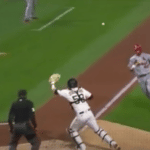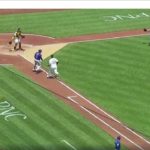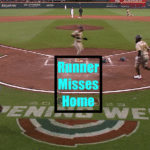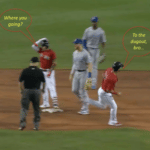ABANDONING BASE PATH (INCLUDING AFTER THIRD STRIKE NOT CAUGHT)
Rules 5.05(a)(2) Comment, 5.09(b)(2) Comment:
Under the Comment to Official Baseball Rule 5.05(a)(2), a batter who strikes out on a third strike not caught is treated differently than the plays relating to abandoning the base paths found in the Comments to Official Baseball Rule 5.09(b).
Specifically, the following interpretations shall govern a batter who has struck out on a third strike not caught:
A batter who does not realize his situation on a third strike not caught, and who is not in the process of running to first base, shall be declared out once the batter leaves the dirt circle surrounding home plate.
The above ruling shall also apply to a batter who strikes out on third strike not caught and who makes no effort to advance to first base within, in the umpire’s judgment, a reasonable amount of time. For example, a batter who “lingers” at home plate, removing a shin guard, and then takes off for first base shall also be declared out.
Due to the variation in size and shape of dirt circles surrounding home plate in different ballparks, in the umpire’s judgment when the batter-runner has shown no effort to advance to first base on a third strike not caught such batter may be declared out. In any case, should the batter leave the dirt circle surrounding home plate before attempting to advance to first base, the batter shall be declared out.
Umpires must be alert to time-play situations when a runner abandons an effort to touch the next base, as demonstrated in the following play:
Play: Bases loaded, two outs, score tied in the bottom of the ninth inning. Batter hits a home run out of the ballpark. Runner on first, thinking the home run automatically wins the game, leaves the baseline and heads toward the dugout. The runner on first is declared out before the runner from third reaches home plate. Other runners continue around the bases and eventually touch home.
Ruling: No runs score; the third out was made before the runner from third touched home plate. Game continues in the top of the tenth inning with the score still tied. NOTE: If there were less than two out, the game would end the moment the winning run touched home plate. See also Official Baseball Rules 5.08(b) and 7.01(g)(3).





